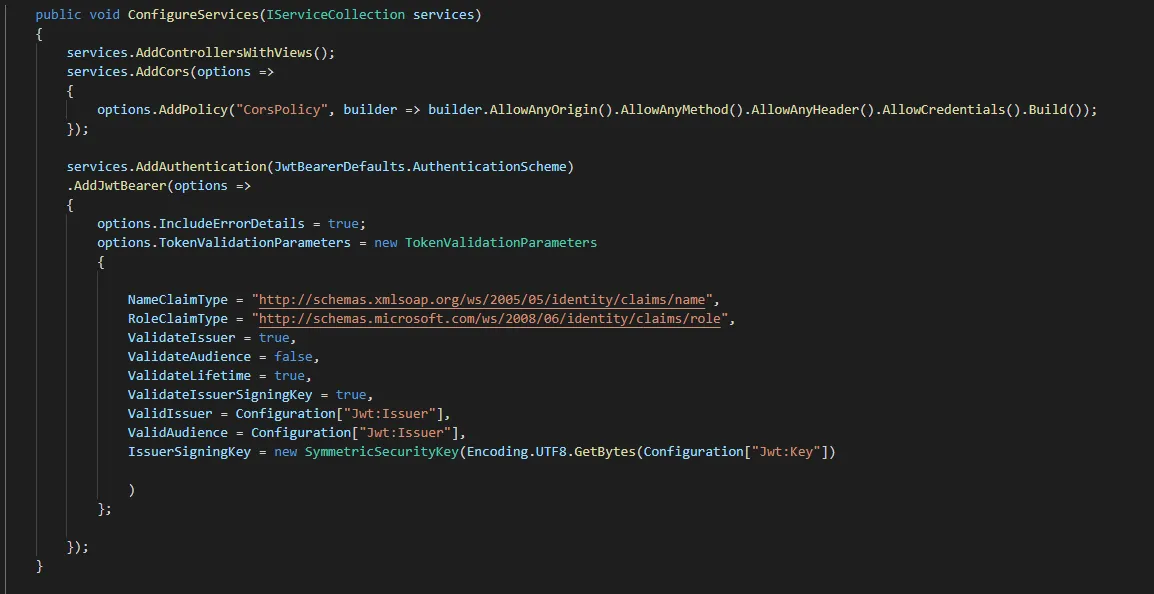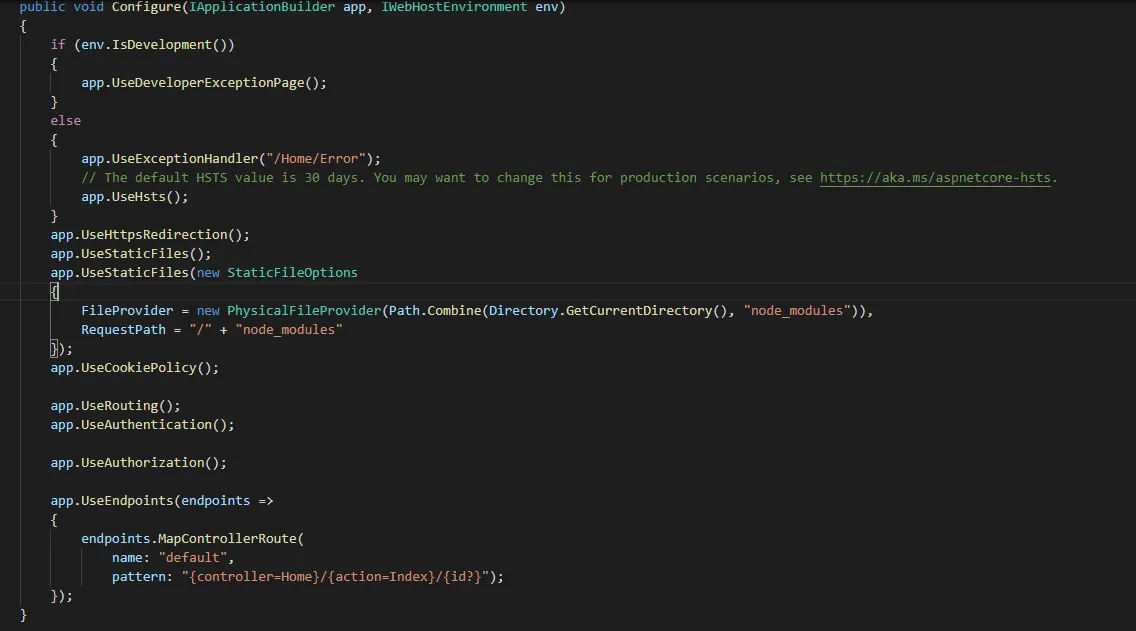@Html.ActionLink("Test","Oper","Home"),授权标头中的令牌并根据我的标准对其进行验证。 我不知道缺了什么,但它总是返回HTTP 401代码。文件
HomeController.cs
private string GenerateJSONWebToken(UserPaul userinfo)
{
var securityKey = new SymmetricSecurityKey(Encoding.UTF8.GetBytes(_config["Jwt:Key"]));
var credentials = new SigningCredentials(securityKey, SecurityAlgorithms.HmacSha256);
var claims = new[]
{
new Claim(JwtRegisteredClaimNames.Sub,userinfo.Username),
new Claim(JwtRegisteredClaimNames.Email,userinfo.Email),
new Claim(JwtRegisteredClaimNames.Jti,Guid.NewGuid().ToString()),
};
var token = new JwtSecurityToken(
issuer: _config["Jwt:Issuer"],
audience: _config["Jwt:Issuer"],
claims,
expires: DateTime.Now.AddMinutes(10),
signingCredentials: credentials
);
var encodetoken = new JwtSecurityTokenHandler().WriteToken(token);
var cookieOptions = new CookieOptions();
cookieOptions.HttpOnly = true;
cookieOptions.Expires = DateTime.Now.AddMinutes(1);
//cookieOptions.Domain = Request.Host.Value;
cookieOptions.Path = "/";
Response.Cookies.Append("jwt", encodetoken, cookieOptions);
return encodetoken;
}
[HttpPost]
public IActionResult Login()
{
string AccountNumber="TestUser";
JWTtokenMVC.Models.TestContext userQuery = new JWTtokenMVC.Models.TestContext();
var query = userQuery.Testxxxx.Where(N => N.UserId ==AccountNumber).FirstOrDefault();
IActionResult response = Unauthorized();
if (query != null)
{
var tokenStr = GenerateJSONWebToken(query);
response = Ok(new { token = tokenStr });
}
return response;
}
[Authorize]
[HttpGet("Home/Oper")]
public IActionResult Oper()
{
var authenticationCookieName = "jwt";
var cookie = HttpContext.Request.Cookies[authenticationCookieName];
List<Test_SHOW> sHOWs = new List<Test_SHOW>();
JWTtokenMVC.Models.Test.TestContext userQuery= new JWTtokenMVC.Models.Test.TestContext();
var query = userQuery.Test.Select(T => new Test_SHOW
{number= T.number,name= T.name,mail= T.mail}).OrderBy(o => o.Iid);
sHOWs.AddRange(query);
return View("Views/Home/Oper.cshtml", sHOWs);
}
这是Startup.cs的代码。
using System;
using System.Collections.Generic;
using System.Linq;
using System.Threading.Tasks;
using Microsoft.AspNetCore.Builder;
using Microsoft.AspNetCore.Hosting;
using Microsoft.AspNetCore.HttpsPolicy;
using Microsoft.Extensions.Configuration;
using Microsoft.Extensions.DependencyInjection;
using Microsoft.Extensions.Hosting;
using Microsoft.Extensions.FileProviders;
using System.IO;
using Microsoft.IdentityModel.Tokens;
using System.Text;
using Microsoft.AspNetCore.Authentication.JwtBearer;
namespace JWTtokenMVC
{
public class Startup
{
public Startup(IConfiguration configuration)
{
Configuration = configuration;
}
public IConfiguration Configuration { get; }
// This method gets called by the runtime. Use this method to add services to the container.
public void ConfigureServices(IServiceCollection services)
{
services.AddControllersWithViews();
services.AddCors(options =>
{
options.AddPolicy("CorsPolicy", builder => builder.AllowAnyOrigin().AllowAnyMethod().AllowAnyHeader().AllowCredentials().Build());
});
services.AddAuthentication(JwtBearerDefaults.AuthenticationScheme)
.AddJwtBearer(options =>
{
options.IncludeErrorDetails = true;
options.TokenValidationParameters = new TokenValidationParameters
{
NameClaimType ="http://schemas.xmlsoap.org/ws/2005/05/identity/claims/name",
RoleClaimType = "http://schemas.microsoft.com/ws/2008/06/identity/claims/role",
ValidateIssuer = true,
ValidateAudience = false,
ValidateLifetime = true,
ValidateIssuerSigningKey = true,
ValidIssuer = Configuration["Jwt:Issuer"],
ValidAudience = Configuration["Jwt:Issuer"],
IssuerSigningKey = new SymmetricSecurityKey(Encoding.UTF8.GetBytes(Configuration["Jwt:Key"])
)
};
});
}
// This method gets called by the runtime. Use this method to configure the HTTP request pipeline.
public void Configure(IApplicationBuilder app, IWebHostEnvironment env)
{
if (env.IsDevelopment())
{
app.UseDeveloperExceptionPage();
}
else
{
app.UseExceptionHandler("/Home/Error");
// The default HSTS value is 30 days. You may want to change this for production scenarios, see https://aka.ms/aspnetcore-hsts.
app.UseHsts();
}
app.UseHttpsRedirection();
app.UseStaticFiles();
app.UseStaticFiles(new StaticFileOptions
{
FileProvider = new PhysicalFileProvider(Path.Combine(Directory.GetCurrentDirectory(), "node_modules")),
RequestPath = "/" + "node_modules"
});
app.UseCookiePolicy();
app.UseRouting();
app.UseAuthentication();
app.UseAuthorization();
app.UseEndpoints(endpoints =>
{
endpoints.MapControllerRoute(
name: "default",
pattern: "{controller=Home}/{action=Index}/{id?}");
});
}
}
}
Startup.cs 图片
Startup.cs 添加 UseAuthentication

